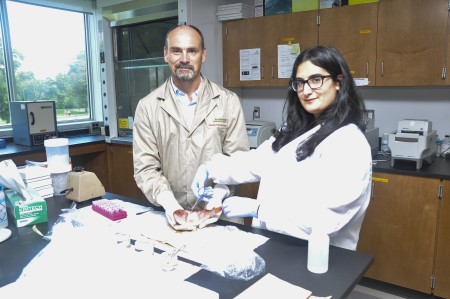Has a rare or invasive species recently occupied a particular river or lake? University of Guelph researchers will use new federal funding to develop a tool for better tracking of aquatic organisms, including invaders or endangered species.
Researchers at the Biodiversity Institute of Ontario (BIO) have received an Idea to Innovation grant worth $125,000 from the Natural Sciences and Engineering Research Council of Canada (NSERC) to perfect a mobile biodiversity monitoring instrument.

This device will allow a user to analyze a water sample for “environmental DNA” (eDNA) and confirm whether a particular organism was recently in that water body, said Prof. Bob Hanner, associate director of the Canadian Barcode of Life network based at BIO.
Such a real-time device is of growing interest to power companies, regulatory agencies and environmental inspectors, among others, he said.
“Ideas to Innovation grants support research intended to lead to a specific product,” Hanner said.
“If there are concerns about invasive species, this can help us figure out if we have reason to be concerned.”
He said traditional environmental impact assessments can be time-consuming and costly, and can even harm some species.
This proposed test would require a small water sample (0.5 to 1.5 litres) and could be used even in winter, he said.
Hanner and post-doctoral researcher Amanda Naaum say it will take about a year to develop a prototype.
“Environmental DNA can be tested in high-tech labs such as what we have at BIO, but this is not always effective,” said Naaum. She recently received a Young Scientist Award from the International Union of Food Science and Technology to continue developing kits to identify seafood species.
“eDNA starts to degrade almost immediately, so the longer it takes to draw a water sample and send to the lab for analysis, the less precise the results are.”
The final product will be designed for use by non-experts for quick identification.
“This is taking eDNA testing and bringing it to a field-ready format, building from our DNA barcode libraries and expertise in this field,” said Naaum. “This funding will help us develop a product beneficial to the environment and in demand by industry.”
Using DNA barcoding to help make sense of global and complex food supply chains is discussed in Seafood Authenticity and Traceability: a DNA-Based Perspective, a new book co-edited by Hanner and Naaum just now available for purchase.
“People want to know what they are eating, as poor seafood labelling could lead to health dangers,” said Naaum.
“Sustainability is also a major issue, and DNA testing can help identify species and populations for improved stock management and policing of illegal, unreported and unregulated fishing. The book discusses potential improvements for identifying fish and improved mobility of testing.”